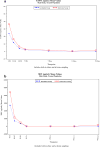Assessment of the vaginal residence time of biomarkers of semen exposure
- PMID: 27259675
- PMCID: PMC5075505
- DOI: 10.1016/j.contraception.2016.05.012
Assessment of the vaginal residence time of biomarkers of semen exposure
Abstract
Objective: The primary objective of this pilot study is to determine and compare the residence time in the vagina of biomarkers of semen exposure for up to 15 days post exposure. The biomarkers are prostate-specific antigen (PSA), Y chromosome DNA, the sex determining region of the Y chromosome (SRY) and testis-specific protein Y-encoded 4 (TSPY4). The secondary objectives are to determine if biomarker concentrations differed between intercourse and inoculation groups, to establish whether the sampling frequency post exposure affected biomarker concentrations and decay profile and to determine if biomarker concentrations in vaginal swabs obtained by the participant at home were similar to swabs obtained by the nurse in the clinic.
Study design: We randomized healthy women to unprotected intercourse (n=17) versus vaginal inoculation with the male partner's semen in the clinic (n=16). Women were then further randomized to have vaginal swabs obtained at either 7 or 4 time points after semen exposure, up to 15 days post exposure, either obtained at home by the participant or in the clinic by the research nurse.
Results: PSA and SRY were markers of recent semen exposure. TSPY4 was detectable in approximately 50% of participants at 15 days post exposure. Unprotected intercourse resulted in significantly higher concentrations of select biomarkers. Sampling frequency and home versus clinic sampling had no significant effect on biomarker concentrations.
Conclusions: Objective biomarkers of recent or distant semen exposure may have great utility for verifying protocol compliance in a variety of clinical trials.
Trial registration: ClinicalTrials.gov NCT00984555.
Keywords: Biomarker; Clinical trials; Semen; Y chromosome.
Copyright © 2016 Elsevier Inc. All rights reserved.
Conflict of interest statement
☆☆ No authors report any conflicts of interest.
Figures



Similar articles
-
TSPY4 is a novel sperm-specific biomarker of semen exposure in human cervicovaginal fluids; potential use in HIV prevention and contraception studies.Contraception. 2013 Sep;88(3):387-95. doi: 10.1016/j.contraception.2012.11.022. Epub 2012 Dec 7. Contraception. 2013. PMID: 23312930
-
Evaluation of prostate-specific antigen as a quantifiable indicator of condom failure in clinical trials.Contraception. 1999 Nov;60(5):289-98. doi: 10.1016/s0010-7824(99)00098-0. Contraception. 1999. PMID: 10717781 Clinical Trial.
-
Detection of two biological markers of intercourse: prostate-specific antigen and Y-chromosomal DNA.Contraception. 2013 Dec;88(6):749-57. doi: 10.1016/j.contraception.2013.08.003. Epub 2013 Aug 14. Contraception. 2013. PMID: 24028752 Free PMC article.
-
Biomarkers of semen in the vagina: applications in clinical trials of contraception and prevention of sexually transmitted pathogens including HIV.Contraception. 2007 Jun;75(6):407-19. doi: 10.1016/j.contraception.2007.02.007. Epub 2007 Apr 30. Contraception. 2007. PMID: 17519146 Review.
-
The use of PSA as a biomarker of recent semen exposure in female reproductive health studies.J Reprod Immunol. 2021 Nov;148:103381. doi: 10.1016/j.jri.2021.103381. Epub 2021 Sep 9. J Reprod Immunol. 2021. PMID: 34563757 Review.
Cited by
-
Biological Validation of Self-Reported Unprotected Sex and Comparison of Underreporting Over Two Different Recall Periods Among Female Sex Workers in Benin.Open Forum Infect Dis. 2019 Jan 9;6(2):ofz010. doi: 10.1093/ofid/ofz010. eCollection 2019 Feb. Open Forum Infect Dis. 2019. PMID: 30746385 Free PMC article.
-
A longitudinal analysis of the vaginal microbiota and vaginal immune mediators in women from sub-Saharan Africa.Sci Rep. 2017 Sep 20;7(1):11974. doi: 10.1038/s41598-017-12198-6. Sci Rep. 2017. PMID: 28931859 Free PMC article.
-
Y Chromosome DNA in Women's Vaginal Samples as a Biomarker of Recent Vaginal Sex and Condom Use With Male Partners in the HPV Infection and Transmission Among Couples Through Heterosexual Activity Cohort Study.Sex Transm Dis. 2018 Jan;45(1):28-34. doi: 10.1097/OLQ.0000000000000688. Sex Transm Dis. 2018. PMID: 28876295 Free PMC article.
-
Transient association between semen exposure and biomarkers of genital inflammation in South African women at risk of HIV infection.J Int AIDS Soc. 2021 Jun;24(6):e25766. doi: 10.1002/jia2.25766. J Int AIDS Soc. 2021. PMID: 34164927 Free PMC article. Clinical Trial.
-
The Impact of Semen Exposure on the Immune and Microbial Environments of the Female Genital Tract.Front Reprod Health. 2020 Nov 9;2:566559. doi: 10.3389/frph.2020.566559. eCollection 2020. Front Reprod Health. 2020. PMID: 36304709 Free PMC article.
References
-
- Graves HC, Sensabaugh GF, Blake ET. Postcoital detection of a male-specific semen protein. Application to the investigation of rape. N Engl J Med. 1985;312:338–43. - PubMed
-
- Mauck CK, Weaver MA, Schwartz JL, Walsh T, Joanis C. Critical next steps for female condom research–report from a workshop. Contraception. 2009;79:339–44. - PubMed
-
- Mauck CK. Biomarkers of semen exposure. Sex Transm Dis. 2009;36:S81–3. - PubMed
-
- Mauck CK, Straten A. Using objective markers to assess participant behavior in HIV prevention trials of vaginal microbicides. J Acquir Immune Defic Syndr. 2008;49:64–9. - PubMed
-
- Ghanem KG, Melendez JH, McNeil-Solis C, Giles JA, Yuenger J, Smith TD, et al. Condom use and vaginal Y-chromosome detection: the specificity of a potential biomarker. Sex Transm Dis. 2007;34:620–3. - PubMed
Publication types
MeSH terms
Substances
Associated data
Grants and funding
LinkOut - more resources
Full Text Sources
Other Literature Sources
Medical
Research Materials
Miscellaneous

